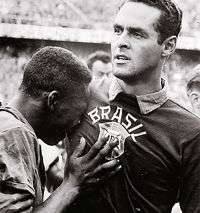Gylmar dos Santos Neves
Gylmar dos Santos Neves (Brazilian Portuguese: [ʒiwˈmaɾ duˈsɐ̃tus ˈnɛvis]; 22 August 1930 – 25 August 2013) known simply as Gilmar (with an i), was a Brazilian footballer who played goalkeeper for Corinthians and Santos and was a member of the Brazil national team in three World Cups.[2] He was elected the best Brazilian goalkeeper of the 20th century and one of the best in the world by the IFFHS. He is remembered for his sober style on the pitch and his peaceful personality.[3]
 | |||||||||||||||||||||||||||||||
| Personal information | |||||||||||||||||||||||||||||||
|---|---|---|---|---|---|---|---|---|---|---|---|---|---|---|---|---|---|---|---|---|---|---|---|---|---|---|---|---|---|---|---|
| Full name | Gylmar dos Santos Neves | ||||||||||||||||||||||||||||||
| Date of birth | 22 August 1930 | ||||||||||||||||||||||||||||||
| Place of birth | Santos, Brazil | ||||||||||||||||||||||||||||||
| Date of death | 25 August 2013 (aged 83) | ||||||||||||||||||||||||||||||
| Place of death | São Paulo, Brazil | ||||||||||||||||||||||||||||||
| Height | 1.81 m (5 ft 11 1⁄2 in) | ||||||||||||||||||||||||||||||
| Playing position(s) | Goalkeeper | ||||||||||||||||||||||||||||||
| Youth career | |||||||||||||||||||||||||||||||
| 1945–1951 | Jabaquara | ||||||||||||||||||||||||||||||
| Senior career* | |||||||||||||||||||||||||||||||
| Years | Team | Apps | (Gls) | ||||||||||||||||||||||||||||
| 1951–1961 | Corinthians | 486 | (0) | ||||||||||||||||||||||||||||
| 1961–1969 | Santos | 266 | (0) | ||||||||||||||||||||||||||||
| Total | 752 | (0) | |||||||||||||||||||||||||||||
| National team | |||||||||||||||||||||||||||||||
| 1953–1969[1] | Brazil | 94 | (0) | ||||||||||||||||||||||||||||
Honours
| |||||||||||||||||||||||||||||||
| * Senior club appearances and goals counted for the domestic league only | |||||||||||||||||||||||||||||||
In the book by Alex Bellos, Futebol: The Brazilian Way of Life, it is reported that Gilmar is named after his parents, Gilberto and Maria. Gilmar was the starting goalkeeper for Pelé's world-famous Santos and Brazilian national teams of the 1960s. Therefore, he's famous around the world as "Pelé's goalkeeper." In 1998, he was awarded the FIFA Order of Merit.[4]
Club career
Gilmar was born in Santos, São Paulo, and started his career playing for hometown side Jabaquara. In 1951 he joined Corinthians, winning three Campeonato Paulista titles with the club in 1951, 1952 and 1954.
In 1961, Gilmar signed for Santos, being a part of the team who was known as Os Santásticos. An immediate starter, he won five Campeonato Paulista (1962, 1964, 1965, 1967, 1968), five Taça Brasil (1961, 1962, 1963, 1964, 1965), two Copa Libertadores (1962 and 1963) and two Intercontinental Cups (1962 against Eusébio's Benfica and 1963 against Milan).
International career
With the Brazilian national team, Gilmar played 104 times, allowing only 95 goals.[3] He was selected to the national squad for three straight World Cups, between 1958 and 1966.[3] He was part of the starting team in the first two World Cups Brazil won, in 1958 and 1962, and is the only goalkeeper to win two consecutive World Cups in the starting position.
Style of play
Regarded by pundits as one of the greatest Brazilian goalkeepers of all time,[5][6] Gilmar was an agile shot-stopper, who possessed excellent reflexes, and who was also known for his composure under pressure, as well as his ability to inspire a sense of calm and confidence in his defenders.[7]
Honours
Club
- Corinthians[8]
- Campeonato Paulista: 1951, 1952, 1954
- Santos[8]
- Campeonato Brasileiro Série A: 1962, 1963, 1964, 1965, 1968
- Campeonato Paulista: 1962, 1964, 1965, 1967, 1968
- Copa Libertadores: 1962, 1963
References
- "Gilmar dos Santos Neves – International Appearances". Rec.Sport.Soccer Statistics Foundation.
- Agência Brasil. "Morre Gylmar, ex-goleiro da Seleção Brasileira das copas de 1958 e 1962 | Agência Brasil". Agenciabrasil.ebc.com.br. Retrieved 26 August 2013.
- "Gilmar (Obituary)". The Telegraph. 1 September 2013.
- "FIFA Order of Merit" (PDF). Retrieved 21 January 2015.
- "Brazil's greatest goalkeepers". Sky Sports. 2 July 2010. Retrieved 16 March 2018.
- Christopher Atkins (10 January 2013). "Ranking Brazil's 10 Best Goalkeepers of All Time". Bleacher Report. Retrieved 21 January 2019.
- Grahame L. Jones (15 May 2010). "Top World Cup goalkeepers". The Los Angeles Times. Retrieved 16 January 2018.
- "Gilmar, the definitive custodian". FIFA.com. Retrieved 19 October 2015.
External links
| Wikimedia Commons has media related to Gylmar dos Santos Neves. |
- Gylmar dos Santos Neves – FIFA competition record
- Corinthians All Time Best XI Placar Magazine
- Gylmar dos Santos Neves at National-Football-Teams.com
- Profile at goalkeepersaredifferent.com